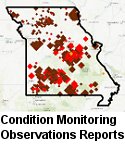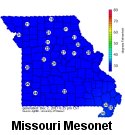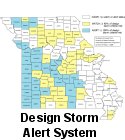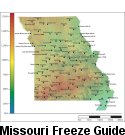
Hail of a Storm
Pat Guinan
State Climatologist
Commercial Agriculture/University of Missouri Extension
Thunderstorms can occur in Missouri any time of the year but close to 60% of them rumble across the state between May and August. Lightning, thunder, and rain are the usual ingredients of a storm but occasionally other elements such as hail and tornadoes will accompany it. Fortunately, most of us will never witness a tornado in our lifetime, but we will likely experience hail.
Hail develops in strong thunderstorms when rapidly rising currents of air, called updrafts, carry raindrops to a height where they freeze. Other droplets of supercooled water will continue to freeze onto the hailstones. Stronger updrafts will produce larger hailstones and they will eventually fall out of the sky when the updraft can no longer support them.
On average, Missourians experience hail 2-3 times a year; most of the time it is smaller than a pea (1/4") and will cause little or no damage. Once in a while, however, the hail can be bigger. The National Weather Service considers a thunderstorm severe if hail is 1-inch in diameter (quarter size) or larger. The maximum diameter a hailstone can grow is about 4.5 inches, or about the size of a softball. These larger hailstones can fall at speeds greater than 100 mph! Fortunately, it is rare to experience hail larger than 0.75 inch in diameter because hail swaths are usually narrow and short lived. The world record hailstone fell on Aurora, NE on June 22, 2003. It had a circumference of 18.75 inches and diameter of 7 inches!!
Hail is also a frequent visitor to our neighbors in the western Great Plains and along the Colorado Front Range. The area where Colorado, Wyoming, and Nebraska meet is known as "Hail Alley." On average, hail falls over this region between 7-9 days a year. One of the costliest hailstorms in U.S. history occurred over Denver, CO on July 11, 1990 when baseball sized fell over the city causing $625 million in property damage, mostly to vehicles and roofs. Thousands of trees were also defoliated. Some people were injured by the large hail as it fell from the sky. A power failure on a Ferris wheel at an amusement park left many people stranded on the ride as the hail began falling. Forty seven people were treated for injuries; fortunately, there were no fatalities. There have been only 5 known U.S. hail fatalities with the last one recorded in 2000. The deadliest hail storm occurred in India on April 30, 1888 where 246 people perished.
The costliest hailstorm in U.S. history was a storm that struck the I-70 corridor of eastern Kansas, across Missouri, into southwestern Illinois on April 10, 2001. Cost estimates exceeded 2 billion dollars with most of the damage occurring in the St. Louis area.
Each year hail causes nearly 1 billion dollars in damage, mostly related to property and agriculture. Wind and hail can be a destructive combination shredding corn and plants in minutes. It can blow out windows of homes and businesses and dent vinyl and aluminum siding. Dime size or 3/4" hail can put small dents in automobiles. Hail larger than 1 1/4" in diameter can damage heavy composite shingles or wood shake shingles. Car windows start to smash when the hail reaches 2 inches in size.
There are some early warning signs to detect hail that is close by or about to strike. If your visibility is not obscured, hail shafts can be seen from a distance. A very light grey or white curtain will extend from the cloud base to ground level. Avoid driving into a hailshaft; pea size hail can quickly become golf ball size hail in seconds. Pull off the road or seek shelter under and overpass. Sometimes a greenish or turquoise sky will occur when a severe thunderstorm is over you. These sky colors have been associated with hail and tornadic producing storms. Lastly, some witnesses of large hail have reported they heard an audible rumble in the distance.












